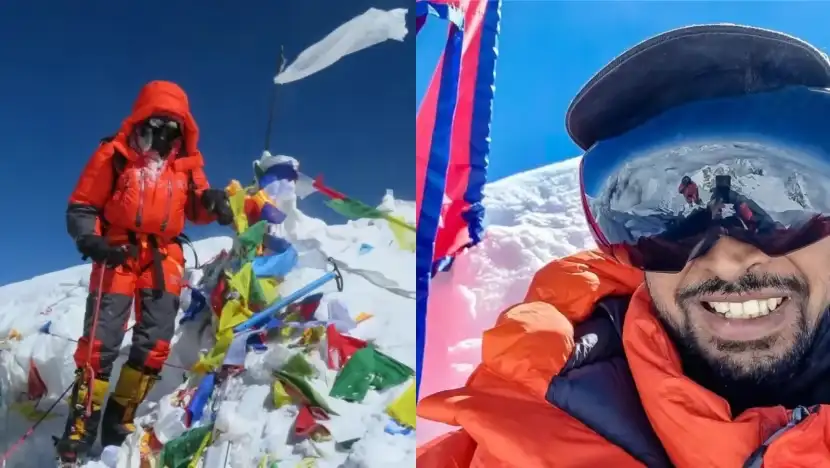Indian Climber Dies After Everest Summit: A Dream That Ended in Tragedy
What was supposed to be a triumphant moment turned into heartbreak when 45-year-old Indian mountaineer Subrata Ghosh died while descending Mount Everest. After successfully reaching the 8,849-meter (29,032-foot) summit, Ghosh collapsed below the Hillary Step on Thursday. Despite earlier warnings, he reportedly refused to turn back, which may have contributed to the tragic outcome.

Every climbing season, Everest attracts hundreds of climbers from around the world. While many reach the top, not everyone makes it home. Ghosh’s death is a harsh reminder of the risks involved in high-altitude mountaineering, where even minor misjudgments can prove fatal.
A Passionate Mountaineer
Subrata Ghosh was known for his deep passion for adventure and mountaineering. Friends and colleagues describe him as a determined individual who had dedicated years to preparing for this expedition. For Ghosh, Everest was more than a challenge—it was a lifelong dream.
He was part of a guided expedition during the spring climbing window when weather conditions are considered relatively favorable. Ghosh reached the summit, achieving what many only aspire to. However, during the descent, he began showing signs of extreme fatigue and distress.
The Hillary Step, where he collapsed, is one of the most treacherous segments near the summit. Though it has changed over the years due to natural forces, it still presents a serious challenge to climbers during both ascent and descent.
Ignoring the Warning Signs
According to accounts from fellow climbers and expedition leaders, Ghosh was advised to descend earlier due to signs of exhaustion. However, determined to make the summit, he chose to press on. This decision, though understandable in the context of ambition and preparation, may have cost him his life.
Altitude sickness, oxygen deprivation, and sheer physical exhaustion are constant threats on Everest. At such elevations, the body begins to shut down, and decision-making can become impaired. For many climbers, it is not the climb up but the way down that turns deadly.
The Dangers Lurking on Everest
While Everest is a symbol of human endurance and adventure, it is also among the deadliest places on Earth. Thin air, sub-zero temperatures, and unpredictable weather make the climb extremely dangerous. The so-called “death zone,” above 8,000 meters, is where most fatalities occur.
Rescues in these extreme conditions are often impossible or severely delayed. Even with proper gear and guidance, climbers face immense challenges. Sadly, Ghosh joins a long list of climbers who have lost their lives in pursuit of the Everest dream.
The tragic irony is that climbers often push themselves hardest after reaching the summit, thinking the worst is over. But history shows that the descent is even more perilous. Fatigue sets in, oxygen runs low, and weather can shift dramatically in a matter of hours.
Remembering Subrata Ghosh
Back home in India, the news of Ghosh’s death has left his family and friends devastated. Tributes have flooded social media, with many remembering his courage and commitment to mountaineering. He inspired many with his dedication and willingness to pursue what few dare to attempt.
His story, though heartbreaking, reflects the spirit of human aspiration. He dared to dream big and reached the peak of the world. While his journey ended tragically, it also serves as a reminder of the importance of caution and humility when facing the forces of nature.
A Call for Safer Expeditions
Ghosh’s death raises broader concerns about climbing safety on Everest. In recent years, the mountain has seen increasing foot traffic, leading to bottlenecks near the summit. These delays not only increase exposure time in dangerous zones but also put immense strain on climbers.
Experts continue to emphasize the importance of training, acclimatization, and strict adherence to safety protocols. More importantly, climbers must listen to their bodies and guides, especially when advised to turn around.
There’s also a need for improved rescue infrastructure and stricter regulations regarding permits and crowd control on Everest. While the Nepalese government and expedition companies do their part, the unpredictable nature of the mountain always leaves gaps.
The Final Lesson
Subrata Ghosh died chasing a dream that many around the world share. His dedication is something to admire, but his death is also a sobering lesson. Everest demands not just physical endurance, but clear thinking and humility in the face of danger.
As more climbers prepare for their attempts this season, Ghosh’s story should serve as a powerful reminder: no summit is worth a life. The mountain will always be there, but safety must come first.
In the end, Subrata Ghosh’s legacy is one of courage and ambition. He dared to reach for the sky—and he did. Though his life ended too soon, his story will continue to inspire and caution those who follow in his footsteps.






